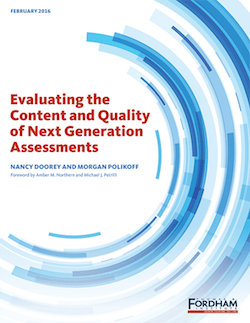 |
PARCC, Smarter Balanced get high marks for content and depth, fidelity to college and career readiness standards; ACT Aspire and MCAS score well for depth of knowledge but fall short on measuring some of the priority content on Common Core, according to Fordham Institute study.
Washington, D.C. (February 11, 2016)—The Thomas B. Fordham Institute today released the results of the first-ever comprehensive analysis of next generation assessments of English Language Arts/Literacy (ELA) and mathematics, which examined secure, un-released items from actual student test forms.
The study, Evaluating the Content and Quality of Next Generation Assessments, found that PARCC and Smarter Balanced assessments have the strongest matches to the Council of Chief State School Officers’ Criteria for Procuring and Evaluating High-Quality Assessment in both ELA/Literacy and mathematics. While ACT Aspire and MCAS both did well regarding the quality of their items and the depth of knowledge assessed, the panelists found that these two programs did not adequately assess—or may not assess at all—some of the priority content reflected in the Common Core standards in both ELA/Literacy and mathematics at one or both grade levels studied (fifth and eighth).
“High-quality assessments, which reflect rigorous standards, have the potential to improve the educational outcomes of millions of American children, and provide parents and the public with needed information about whether or not their kids are on track for college,” said Fordham Institute senior vice president for research Amber Northern. “We are indebted to all four assessment programs that allowed our reviewers access to their test items. Their participation, especially during a period of anxiety about standardized testing, is to be commended.”
The study utilized a methodology developed by the Center for Assessment, which measured fidelity to the CCSSO criteria. Report authors Nancy Doorey, an independent consultant with expertise in assessment, and University of Southern California assistant professor Morgan Polikoff led a team of nearly forty reviewers who analyzed test items at the fifth- and eighth-grade levels. Half of reviewers were practitioners, while the remainder were experts in content and assessment. A complementary analysis, conducted by the Human Resources Research Organization (HumRRO), evaluated high-school exams and as well as all exams’ accessibility for English language learners and students with special needs.
“This evaluation allows policymakers for the first time to reliably compare different options for assessment of student learning,” says Michael J. Petrilli, president of the Fordham Institute. “It provides direct feedback to testing organizations about the strengths and weaknesses of their products as they pertain to CCSSO’s Criteria. Communities can use the information to make the best decision for their schools and students.”
The study was funded by the Louis Calder Foundation, Bill and Melinda Gates Foundation, the Leona M. and Harry B. Helmsley Charitable Trust, the William and Flora Hewlett Foundation, the Charles and Lynn Schusterman Foundation, and the Lumina Foundation, along with the Thomas B. Fordham Foundation, the sister organization of the Institute.
The Thomas B. Fordham Institute is the nation’s leader in advancing educational excellence for every child through quality research, analysis, and commentary, as well as on-the-ground action and advocacy in Ohio.